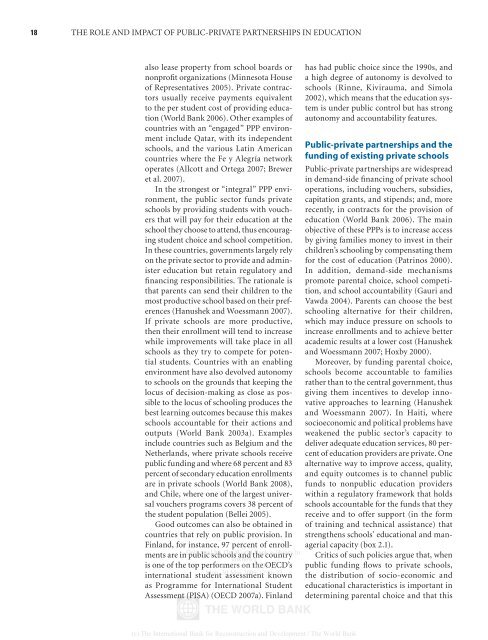The Role and Impact of Public-Private Partnerships in Education
The Role and Impact of Public-Private Partnerships in Education
The Role and Impact of Public-Private Partnerships in Education
You also want an ePaper? Increase the reach of your titles
YUMPU automatically turns print PDFs into web optimized ePapers that Google loves.
18 THE ROLE AND IMPACT OF PUBLIC-PRIVATE PARTNERSHIPS IN EDUCATION<br />
also lease property from school boards or<br />
nonpr<strong>of</strong>it organizations (M<strong>in</strong>nesota House<br />
<strong>of</strong> Representatives 2005). <strong>Private</strong> contractors<br />
usually receive payments equivalent<br />
to the per student cost <strong>of</strong> provid<strong>in</strong>g education<br />
(World Bank 2006). Other examples <strong>of</strong><br />
countries with an “engaged” PPP environment<br />
<strong>in</strong>clude Qatar, with its <strong>in</strong>dependent<br />
schools, <strong>and</strong> the various Lat<strong>in</strong> American<br />
countries where the Fe y Alegría network<br />
operates (Allcott <strong>and</strong> Ortega 2007; Brewer<br />
et al. 2007).<br />
In the strongest or “<strong>in</strong>tegral” PPP environment,<br />
the public sector funds private<br />
schools by provid<strong>in</strong>g students with vouchers<br />
that will pay for their education at the<br />
school they choose to attend, thus encourag<strong>in</strong>g<br />
student choice <strong>and</strong> school competition.<br />
In these countries, governments largely rely<br />
on the private sector to provide <strong>and</strong> adm<strong>in</strong>ister<br />
education but reta<strong>in</strong> regulatory <strong>and</strong><br />
f<strong>in</strong>anc<strong>in</strong>g responsibilities. <strong>The</strong> rationale is<br />
that parents can send their children to the<br />
most productive school based on their preferences<br />
(Hanushek <strong>and</strong> Woessmann 2007).<br />
If private schools are more productive,<br />
then their enrollment will tend to <strong>in</strong>crease<br />
while improvements will take place <strong>in</strong> all<br />
schools as they try to compete for potential<br />
students. Countries with an enabl<strong>in</strong>g<br />
environment have also devolved autonomy<br />
to schools on the grounds that keep<strong>in</strong>g the<br />
locus <strong>of</strong> decision-mak<strong>in</strong>g as close as possible<br />
to the locus <strong>of</strong> school<strong>in</strong>g produces the<br />
best learn<strong>in</strong>g outcomes because this makes<br />
schools accountable for their actions <strong>and</strong><br />
outputs (World Bank 2003a). Examples<br />
<strong>in</strong>clude countries such as Belgium <strong>and</strong> the<br />
Netherl<strong>and</strong>s, where private schools receive<br />
public fund<strong>in</strong>g <strong>and</strong> where 68 percent <strong>and</strong> 83<br />
percent <strong>of</strong> secondary education enrollments<br />
are <strong>in</strong> private schools (World Bank 2008),<br />
<strong>and</strong> Chile, where one <strong>of</strong> the largest universal<br />
vouchers programs covers 38 percent <strong>of</strong><br />
the student population (Bellei 2005).<br />
Good outcomes can also be obta<strong>in</strong>ed <strong>in</strong><br />
countries that rely on public provision. In<br />
F<strong>in</strong>l<strong>and</strong>, for <strong>in</strong>stance, 97 percent <strong>of</strong> enrollments<br />
are <strong>in</strong> Delivered public schools by <strong>The</strong> World <strong>and</strong> the Bank country e-library to:<br />
unknown<br />
is one <strong>of</strong> the top performers IP : 192.86.100.35 on the OECD’s<br />
<strong>in</strong>ternational student Mon, 30 assessment Mar 2009 12:16:23 known<br />
as Programme for International Student<br />
Assessment (PISA) (OECD 2007a). F<strong>in</strong>l<strong>and</strong><br />
has had public choice s<strong>in</strong>ce the 1990s, <strong>and</strong><br />
a high degree <strong>of</strong> autonomy is devolved to<br />
schools (R<strong>in</strong>ne, Kivirauma, <strong>and</strong> Simola<br />
2002), which means that the education system<br />
is under public control but has strong<br />
autonomy <strong>and</strong> accountability features.<br />
<strong>Public</strong>-private partnerships <strong>and</strong> the<br />
fund<strong>in</strong>g <strong>of</strong> exist<strong>in</strong>g private schools<br />
<strong>Public</strong>-private partnerships are widespread<br />
<strong>in</strong> dem<strong>and</strong>-side f<strong>in</strong>anc<strong>in</strong>g <strong>of</strong> private school<br />
operations, <strong>in</strong>clud<strong>in</strong>g vouchers, subsidies,<br />
capitation grants, <strong>and</strong> stipends; <strong>and</strong>, more<br />
recently, <strong>in</strong> contracts for the provision <strong>of</strong><br />
education (World Bank 2006). <strong>The</strong> ma<strong>in</strong><br />
objective <strong>of</strong> these PPPs is to <strong>in</strong>crease access<br />
by giv<strong>in</strong>g families money to <strong>in</strong>vest <strong>in</strong> their<br />
children’s school<strong>in</strong>g by compensat<strong>in</strong>g them<br />
for the cost <strong>of</strong> education (Patr<strong>in</strong>os 2000).<br />
In addition, dem<strong>and</strong>-side mechanisms<br />
promote parental choice, school competition,<br />
<strong>and</strong> school accountability (Gauri <strong>and</strong><br />
Vawda 2004). Parents can choose the best<br />
school<strong>in</strong>g alternative for their children,<br />
which may <strong>in</strong>duce pressure on schools to<br />
<strong>in</strong>crease enrollments <strong>and</strong> to achieve better<br />
academic results at a lower cost (Hanushek<br />
<strong>and</strong> Woessmann 2007; Hoxby 2000).<br />
Moreover, by fund<strong>in</strong>g parental choice,<br />
schools become accountable to families<br />
rather than to the central government, thus<br />
giv<strong>in</strong>g them <strong>in</strong>centives to develop <strong>in</strong>novative<br />
approaches to learn<strong>in</strong>g (Hanushek<br />
<strong>and</strong> Woessmann 2007). In Haiti, where<br />
socioeconomic <strong>and</strong> political problems have<br />
weakened the public sector’s capacity to<br />
deliver adequate education services, 80 percent<br />
<strong>of</strong> education providers are private. One<br />
alternative way to improve access, quality,<br />
<strong>and</strong> equity outcomes is to channel public<br />
funds to nonpublic education providers<br />
with<strong>in</strong> a regulatory framework that holds<br />
schools accountable for the funds that they<br />
receive <strong>and</strong> to <strong>of</strong>fer support (<strong>in</strong> the form<br />
<strong>of</strong> tra<strong>in</strong><strong>in</strong>g <strong>and</strong> technical assistance) that<br />
strengthens schools’ educational <strong>and</strong> managerial<br />
capacity (box 2.1).<br />
Critics <strong>of</strong> such policies argue that, when<br />
public fund<strong>in</strong>g flows to private schools,<br />
the distribution <strong>of</strong> socio-economic <strong>and</strong><br />
educational characteristics is important <strong>in</strong><br />
determ<strong>in</strong><strong>in</strong>g parental choice <strong>and</strong> that this<br />
(c) <strong>The</strong> International Bank for Reconstruction <strong>and</strong> Development / <strong>The</strong> World Bank
















